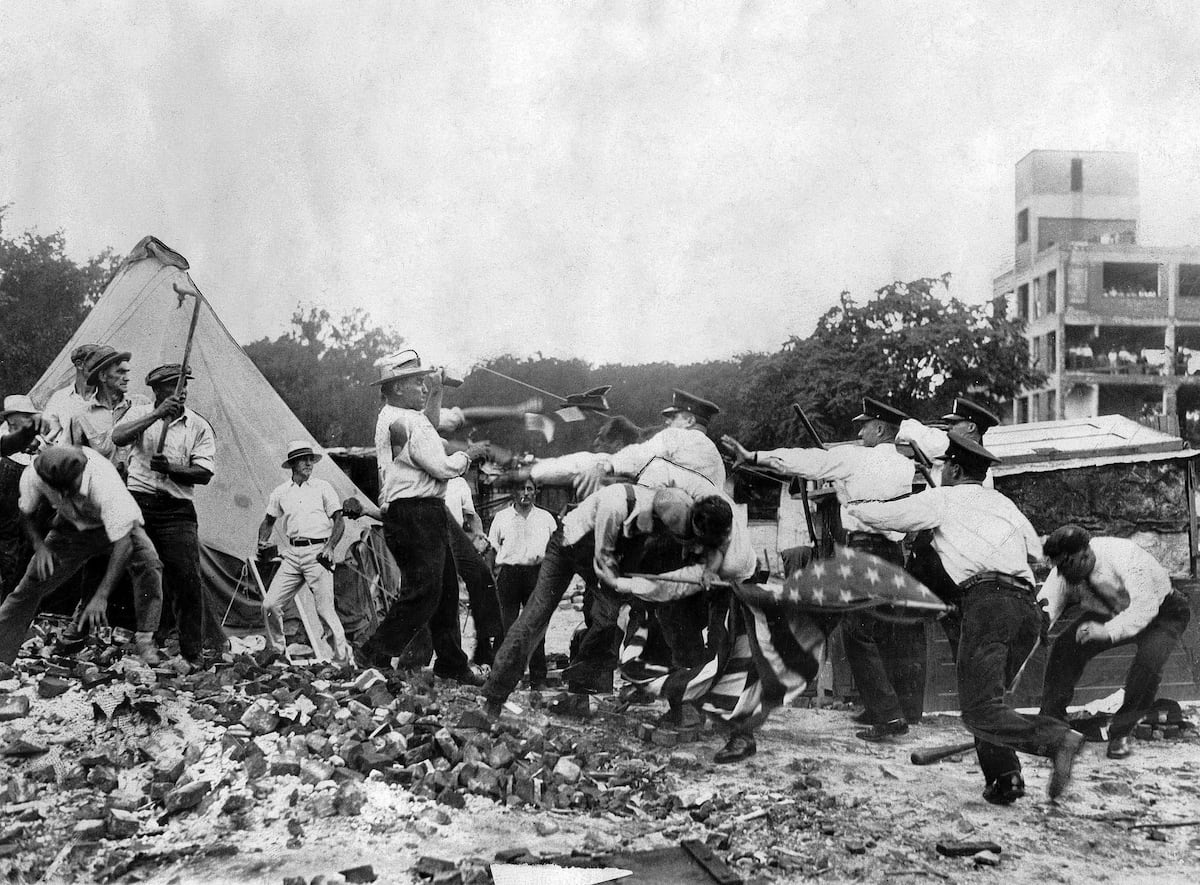Lifestyle
U.S. Army Clears Bonus Army in Daring Show of Force

On July 28, 1932, a significant and controversial confrontation unfolded in Washington D.C. as U.S. Army troops, commanded by Army Chief of Staff Douglas MacArthur, forcibly cleared the Bonus Army, a group of World War I veterans demanding immediate payment of bonuses promised to them. The operation, which involved infantry, cavalry, and armored vehicles, escalated tensions between the government and its citizens during the depths of the Great Depression.
The Bonus Army, consisting of approximately 20,000 veterans and their families, had gathered in the nation’s capital to advocate for the Patman Bill, which sought to expedite bonus payments scheduled for 1945. Many of these veterans were destitute and desperate, having traveled across the country by freight train or on foot to join the protest. Despite the initial peaceful demonstrations, the situation took a turn for the worse as tensions rose between the veterans and government forces.
As the sun set on Pennsylvania Avenue, MacArthur led a military procession that included soldiers in full gear, cavalry units, and World War I-era tanks. The spectacle drew the attention of onlookers, many of whom were office workers who paused to witness the unfolding drama. The veterans, some in tattered uniforms, were taken by surprise as the military approached their makeshift encampment with a show of force.
Faced with the intimidating advance of approximately 600 soldiers, the veterans reacted in disbelief. As they attempted to defend their position, some threw stones and bottles, which proved ineffective against the disciplined troops. The clash escalated quickly, with soldiers deploying tear gas to disperse the crowd. Eyewitness accounts recount a chaotic scene as veterans fled in panic, while the Army maintained its strategy of clearing the area without firing a shot.
According to historians, the Bonus Marchers had originally formed in response to a pressing financial need. The federal government had authorized bonus payments in 1924, but these were not scheduled for disbursement until 1945. In 1931, the government had allowed veterans to access half of the promised amount as loans, but as economic conditions worsened, many sought immediate cash.
The initial march began under the leadership of Walter Waters, a former sergeant from Oregon. Despite efforts to maintain a peaceful and orderly protest, frustrations grew as the summer wore on. Tensions deepened further when the American Communist Party identified an opportunity to incite unrest among the marchers. This led to the presence of John Pace, a noted agitator, who some historians believe may have exacerbated the situation.
As the conflict escalated, Secretary of War Patrick Hurley ordered MacArthur to clear the encampment, citing a need for order and safety. The decision to deploy military force against the veterans drew sharp criticism and raised questions about the government’s treatment of its citizens. Historian Kenneth S. Davis suggests that the perception of the Bonus Army as a threat to national order may have fueled the administration’s response.
Once deployed, MacArthur was determined to execute his orders with efficiency. He chose to oversee the operations personally, a decision that departed from standard military protocol. This hands-on approach, which some argue was meant to garner media attention, led to further confrontations. As troops advanced across the Anacostia River, they encountered resistance from the veterans, resulting in further chaos.
During the confrontation, a tragic incident occurred when police opened fire, killing one veteran and seriously wounding another. The violence prompted public outrage and condemnation of the government’s response. The day concluded with the destruction of the veterans’ encampment, as soldiers set fire to the remaining structures, symbolizing the government’s rejection of their pleas.
The aftermath of the clearing of the Bonus Army left an indelible mark on American politics. President Herbert Hoover, who had already been struggling with the economic crisis, faced significant backlash for his administration’s heavy-handed tactics. Critics, including future President Franklin D. Roosevelt, condemned the use of military force against veterans who had served their country.
The incident was later characterized as one of the darkest moments in American history, reflecting the desperation of the times. Public sentiment shifted, leading to increased support for Roosevelt, who won the presidential election later that year by a landslide, capturing 42 states and signaling a demand for change in government policy.
In the years that followed, the government would eventually address the grievances of the Bonus Army. In 1936, Congress passed legislation to fulfill the veterans’ bonus payments, demonstrating a shift in public policy in response to the economic realities facing many Americans.
The events of July 28, 1932, continue to resonate in discussions about the government’s responsibility towards its veterans and the appropriate use of military force in civil unrest. The controversial actions of MacArthur, Patton, and Hoover during this turbulent period serve as a reminder of the complexities inherent in governance, particularly in times of national crisis.
-

 Lifestyle5 months ago
Lifestyle5 months agoLibraries Challenge Rising E-Book Costs Amid Growing Demand
-

 Sports5 months ago
Sports5 months agoTyreek Hill Responds to Tua Tagovailoa’s Comments on Team Dynamics
-

 Sports5 months ago
Sports5 months agoLiverpool Secures Agreement to Sign Young Striker Will Wright
-

 Lifestyle5 months ago
Lifestyle5 months agoSave Your Split Tomatoes: Expert Tips for Gardeners
-

 Lifestyle5 months ago
Lifestyle5 months agoPrincess Beatrice’s Daughter Athena Joins Siblings at London Parade
-

 Science4 months ago
Science4 months agoSan Francisco Hosts Unique Contest to Identify “Performative Males”
-

 World5 months ago
World5 months agoWinter Storms Lash New South Wales with Snow, Flood Risks
-

 Science5 months ago
Science5 months agoTrump Administration Moves to Repeal Key Climate Regulation
-

 Business5 months ago
Business5 months agoSoFi Technologies Shares Slip 2% Following Insider Stock Sale
-

 Science5 months ago
Science5 months agoNew Tool Reveals Link Between Horse Coat Condition and Parasites
-

 Sports5 months ago
Sports5 months agoElon Musk Sculpture Travels From Utah to Yosemite National Park
-

 Science5 months ago
Science5 months agoNew Study Confirms Humans Transported Stonehenge Bluestones









